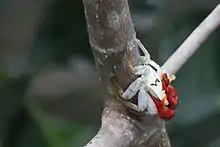Mangrove crab
Mangrove crabs are crabs that live among mangroves, and may belong to many different species and even families. They have been shown to be ecologically significant in many ways. They keep much of the energy within the forest by burying and consuming leaf litter.[1][2] Along with burrowing in the ground,[3] at high tide and in the face of predators these crustaceans can climb trees to protect themselves.[4] The hermit crab and the mangrove crab are the only crustaceans that can climb trees as a defense mechanism.[5] Furthermore, their feces may form the basis of a coprophagous food chain contributing to mangrove secondary production.[6][7]
.jpg.webp)
Neosarmatium meinerti

Mangrove crab larvae are the major source of food for juvenile fish inhabiting the adjacent waterways, indicating that crabs also help nearshore fisheries.[8] The adult crabs are food for threatened species such as the crab plover.[9]
Their burrows alter the topography and sediment grain size of the mangrove,[10] and help aerate the sediment.[11] Removing crabs from an area causes significant increases in sulfides and ammonium concentrations, which in turn affects the productivity and reproductive output of the vegetation, supporting the hypothesis that mangrove crabs are a keystone species.[12]
Species of mangrove crabs
- Aratus pisonii, Americas
- Haberma, genus of small mangrove crabs, Indo-Pacific, including:
- Haberma tingkok, Hong Kong
- Metopograpsus messor, Indo-Pacific
- Metopograpsus thukuhar, Indo-Pacific
- Neosarmatium meinerti, Indo-Pacific[13]
- Neosarmatium smithi, Indo-Pacific[14]
- Parasesarma leptosoma, western Indian Ocean
- Perisesarma, genus with 23 species, primarily Indo-Pacific, with two West African species, including:
- Perisesarma bidens, Indo-Pacific
- Perisesarma guttatum, western Indian Ocean
- Scylla serrata, Indo-Pacific
- Scylla tranquebarica, Indo-Pacific
- Sesarma, genus with close to 20 species, many of which live in mangroves, Americas, Indo-Pacific
- Ucides cordatus, western Atlantic Ocean
See also
- Fiddler crab
- Grapsidae
- Mangrove ecoregions
References
- Tomas Tomascik (1997). The Ecology of the Indonesian Seas. Oxford University Press. pp. 356–. ISBN 978-0-19-850186-2.
- Luiz Drude de Lacerda; Volker Linneweber (26 March 2002). Mangrove Ecosystems: Function and Management. Springer Science & Business Media. pp. 97–. ISBN 978-3-540-42208-2.
- Christopher Makowski; Charles W. Finkl (20 April 2018). Threats to Mangrove Forests: Hazards, Vulnerability, and Management. Springer. pp. 546–. ISBN 978-3-319-73016-5.
- Peter K. L. Ng; Richard Corlett; Hugh T. W. Tan (2011). Singapore Biodiversity: An Encyclopedia of the Natural Environment and Sustainable Development. Editions Didier Millet. pp. 454–. ISBN 978-981-4260-08-4.
- John Kricher (18 February 2015). A Neotropical Companion: An Introduction to the Animals, Plants, and Ecosystems of the New World Tropics. Illustrated by Andrea S. LeJeune. Princeton University Press. pp. 242–. ISBN 978-1-4008-6691-5.
- S. Y. Lee (1997). "Potential trophic importance of the faecal material of the mangrove crab Sesarma messa" (PDF). Marine Ecology Progress Series. 159: 275–284. doi:10.3354/meps159275.
- David Paul Gillikin; Sammy De Grave & Jurgen F. Tack (2001). "The occurrence of the semi-terrestrial shrimp Merguia oligodon (De Man, 1888) in Neosarmatium smithi H. Milne Edwards, 1853 burrows in Kenyan mangroves" (PDF). Crustaceana. 74 (5): 505–508. doi:10.1163/156854001750243081.
- A. I. Robertson; D. M. Alongi & K. G. Boto (1992). "Food chains and carbon fluxes". In A. I. Robertson & Daniel M. Alongi (eds.). Tropical Mangrove Ecosystems. Coastal and Estuarine Studies No. 41. Washington, DC: American Geophysical Union. pp. 293–326. ISBN 0-87590-255-3.
- J. Seys; G. Moragwa; P. Boera; M. Ngoa (1995). "Distribution and abundance of birds in tidal creeks and estuaries of the Kenyan coast between the Sabaki river and Gazi Bay". Scopus. 19: 47–60. Retrieved 2020-03-16.
- J. H. Warren & A. J. Underwood (1986). "Effects of burrowing crabs on the topography of mangrove swamps in New South Wales". Journal of Experimental Marine Biology and Ecology. 102 (2–3): 223–236. doi:10.1016/0022-0981(86)90178-4.
- Peter V. Ridd (1996). "Flow through animal burrows in mangrove creeks". Estuarine, Coastal and Shelf Science. 43 (5): 617–625. Bibcode:1996ECSS...43..617R. doi:10.1006/ecss.1996.0091.
- Thomas J. Smith, III; Kevin G. Boto; Stewart D. Frusher & Raymond L. Giddins (1991). "Keystone species and mangrove forest dynamics: the influence of burrowing by crabs on soil nutrient status and forest productivity". Estuarine, Coastal and Shelf Science. 33 (5): 419–432. Bibcode:1991ECSS...33..419S. doi:10.1016/0272-7714(91)90081-L.
- "Marine Species Identification Portal : Neosarmatium meinerti". species-identification.org. Retrieved 2020-03-15.
- Giddins, R. L.; Lucas, J. S.; Nielson, M. J.; Richards, G. N. (October 15, 1986). "Feeding ecology of the mangrove crab Neosarmatium smithi (Crustacea: Decapoda: Sesarmidae)". Marine Ecology Progress Series. 33: 147–155. Bibcode:1986MEPS...33..147G. doi:10.3354/meps033147.
External links
- East African mangrove crabs
- Spotted Mangrove Crab (Caribbean and Florida)
- Mangrove Crab Aquaculture
- Mangrove crabs at Sungei Buloh Nature Park
- Mangrove crab Ucides cordatus (Brazil)
- Complete larval and early juvenile development of the mangrove crab Perisesarma fasciatum (Singapore)
- Laboratory cultured zoeae and megalopa of the mangrove crab Metaplax distincta
- Regulation of pulmonary blood flow and of blood pressure in a mangrove crab (Goniopsis cruentata)
- Haberma nanum, a new genus and new species of mangrove crab from Singapore
